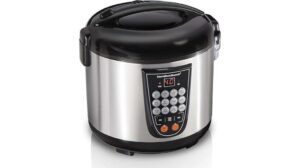As a dog owner, you want the best for your furry companion. You carefully choose their food, ensuring it’s nutritious and safe for them to consume. But have you ever considered cooking rice for your dog? It may not be something you’ve thought about before, but incorporating rice into their diet can have numerous benefits.
Rice is not only a dog-friendly ingredient, but it’s also easily digestible and provides essential carbohydrates for energy. It can be especially helpful for dogs with sensitive stomachs or those recovering from digestive issues. Plus, cooking rice for your dog allows you to customize their meals and ensure they’re getting a balanced diet.
In this article, we will guide you through the process of cooking rice for your dog. From choosing the right rice to preparing it safely, we’ll cover everything you need to know to make delicious and nutritious homemade meals for your canine companion.
Table of Contents
Key Takeaways:
- Cooking rice for dogs can provide them with a nutritious and easily digestible meal.
- Rice is a dog-friendly ingredient that can be beneficial for dogs with sensitive stomachs.
- Choosing plain white rice is recommended over brown rice to ensure easy digestion.
- Enhance your dog’s rice by adding cooked chicken or turkey, steamed vegetables, or low-sodium broth.
- Consult with your veterinarian to determine the appropriate amount of rice to feed your dog based on their specific needs.
Why Rice is Good for Dogs
Rice is a fantastic addition to your dog’s diet due to its numerous nutritional benefits. Being easily digestible, rice provides dogs with the essential carbohydrates needed for energy. It is especially beneficial for dogs with sensitive stomachs or those recovering from digestive issues.
When incorporated into your dog’s diet, rice can contribute to their overall well-being and health. Here are some key benefits that make rice a great choice for your furry friend:
- Rich in nutrients: Rice contains important vitamins and minerals such as selenium, manganese, and magnesium that support your dog’s immune system and promote optimal health.
- Source of energy: The carbohydrates found in rice provide dogs with a readily available source of energy to keep them active and lively throughout the day.
- Gentle on the stomach: Dogs with sensitive stomachs or digestive issues can benefit from the mild nature of rice, which is easy to digest and unlikely to cause any discomfort.
- Helps with diarrhea: Due to its binding properties, rice can help firm up loose stools and alleviate symptoms of diarrhea in dogs.
- Customizable and versatile: Rice serves as a blank canvas that allows you to create a variety of delicious and dog-friendly meals by adding different ingredients such as cooked chicken or turkey, steamed vegetables, and low-sodium broth.
To ensure you’re using the best rice for your dog’s dietary needs, it’s important to consider the type of rice you choose. Let’s take a closer look at the different options available:
Types of Rice for Dogs
| Type of Rice | Description |
|---|---|
| Plain White Rice | Easily digestible and gentle on the stomach, making it an excellent choice for dogs with sensitive digestive systems. |
| Brown Rice | Contains more fiber and nutrients compared to white rice, but may be harder to digest for some dogs. Consult with your veterinarian if you’re considering brown rice for your dog’s diet. |
| Wild Rice | A nutritious option that contains higher protein levels than other rice varieties, but it may have a stronger flavor that some dogs may not prefer. |
When preparing rice for your dog, always cook it plain without any seasonings or additives. Avoid using rice blends or flavored rice that may contain ingredients unsuitable for dog consumption. Remember, consult with your veterinarian for personalized advice about the best type of rice for your specific breed and any dietary concerns.
By understanding the benefits of incorporating rice into your dog’s diet and choosing the right type of rice, you can provide them with a nutritious and enjoyable meal.
Choosing the Right Rice for Your Dog
When it comes to selecting the best rice for your furry friend, it’s important to prioritize their health and dietary needs. Opting for plain white rice is generally the safest and most easily digestible option for dogs. Unlike brown rice, which contains more fiber, plain white rice is gentler on your dog’s stomach and less likely to cause gastrointestinal discomfort.
Flavored rice blends or those with added seasonings may seem tempting, but it’s essential to avoid them. These seasonings can be harmful to dogs and may cause digestive issues or food sensitivities. By selecting unseasoned plain white rice, you ensure that your dog’s meal is safe and beneficial for their overall well-being.
Choosing the right type of rice for your dog is the first step in providing them with a healthy and nourishing meal. Let’s summarize the key points to remember when selecting rice for your dog:
Opt for plain white rice: Plain white rice is easier to digest and less likely to cause gastrointestinal discomfort for your dog.
Avoid brown rice: Brown rice contains more fiber and may be harder for dogs to digest. Stick to plain white rice instead.
Avoid flavored rice blends: Flavored rice blends may contain seasonings that are harmful to dogs. Always choose unseasoned plain rice.
By following these guidelines, you can ensure that the rice you serve your dog is both safe and beneficial for their health. In the next section, we will delve into the process of cooking rice for your dog and share some tips for preparing it safely.
Cooking Rice for Your Dog
Cooking rice for your dog is a simple and nutritious way to provide them with a wholesome meal. By following the proper measurements, rinsing techniques, water ratios, and cooking times, you can ensure that the rice is cooked safely for your furry friend.
1. Measure the Rice
Start by measuring the desired amount of rice for your dog’s meal. It is recommended to use plain white rice, as brown rice may be harder to digest. Use a measuring cup to ensure accurate portions.
2. Rinse the Rice
Rinsing the rice before cooking helps remove any excess starch and impurities. Place the rice in a fine-mesh sieve or colander and rinse it under cold water until the water runs clear. This step will help ensure a cleaner and safer end product for your dog.
3. Determine the Water Ratio
The water ratio is essential for properly cooking rice. For dogs, it is recommended to use a 2:1 water-to-rice ratio. For every cup of rice, you will need two cups of water. This will result in fluffy, fully cooked rice that is easy for your dog to consume.
| Rice | Water |
|---|---|
| 1 cup | 2 cups |
| 2 cups | 4 cups |
| 3 cups | 6 cups |
4. Cook the Rice
Once you have rinsed the rice and determined the water ratio, it’s time to cook the rice. Place the rice and the corresponding amount of water in a pot. Bring it to a boil over medium-high heat, then reduce the heat to low and cover the pot. Allow the rice to simmer for about 15-20 minutes, or until all the water is absorbed and the rice is cooked through.
5. Let the Rice Cool
After cooking, allow the rice to cool completely before serving it to your dog. This will prevent any potential burns and ensure a comfortable dining experience for your pet.
Remember to consult with your veterinarian before introducing any new foods or making dietary changes for your dog. They can provide personalized advice based on your dog’s specific needs and health conditions.
Cooking rice for your dog is a rewarding experience that allows you to provide them with a nutritious and delicious meal. By following these guidelines, you can ensure that the rice is prepared safely and tailored to your dog’s dietary needs.
Enhancing the Rice for Your Dog
While plain cooked rice is suitable for dogs, there are ways to enhance its flavor and nutritional profile. By adding nutritious ingredients to your dog’s rice, you can create homemade dog meals that are both delicious and healthy.
1. Cooked Chicken or Turkey
If you have some leftover cooked chicken or turkey, you can mix it into your dog’s rice to add protein and flavor. Make sure to remove any bones, skin, or seasoning before adding it to the rice. The lean meat is a great source of nutrients for your furry friend.
2. Steamed Vegetables
Adding steamed vegetables to your dog’s rice can provide additional vitamins, minerals, and fiber. Some dog-friendly vegetables include carrots, peas, green beans, and sweet potatoes. Chop the vegetables into small, bite-sized pieces to make them easier for your dog to eat and digest.
3. Low-Sodium Broth
If your dog has a more refined palate and prefers some extra flavor in their rice, you can use a low-sodium broth. Choose a broth that is specifically made for dogs and avoid using seasonings or spices that may be harmful to them. Adding a small amount of broth can make the rice more appealing and appetizing for your dog.
Remember to introduce new ingredients gradually and observe your dog’s reaction. If your dog has any allergies or sensitivities, consult your veterinarian before adding new ingredients to their diet.
Here is an example of a dog-friendly rice recipe:
| Ingredients | Amount |
|---|---|
| Plain cooked rice | 1 cup |
| Cooked chicken or turkey | 1/2 cup |
| Steamed vegetables (carrots, peas, green beans) | 1/2 cup |
| Low-sodium broth | 2-3 tablespoons |
Mix all the ingredients together and serve it to your pup. Always ensure that the rice and other ingredients are thoroughly cooked and properly cooled before serving.
By enhancing the rice with these nutritious additions, you can create homemade meals that provide your dog with a balanced and tasty diet.
Feeding Guidelines for Rice
When it comes to incorporating rice into your dog’s diet, it’s essential to consider their overall nutrition and specific dietary needs. Feeding guidelines and portion sizes may vary depending on factors such as your dog’s size, age, and activity level. Consulting with your veterinarian is crucial to determine the appropriate amount of rice for your furry friend.
Dog nutrition is a key factor to keep in mind while serving rice to your canine companion. While rice can be a nutritious addition to their meals, it should not be the sole component of their diet. It is essential to provide a balanced meal that includes proteins, fats, carbohydrates, and other essential nutrients.
“Feeding your dog a well-balanced diet is crucial for their overall health and well-being. While rice provides carbohydrates and can be a beneficial part of their diet, it should be combined with other nutritious ingredients.”
Here are some general feeding guidelines to consider when incorporating rice into your dog’s meals:
- Start by introducing small amounts of rice into your dog’s diet and monitor their digestion and overall well-being.
- For small-sized dogs, start with about 1/4 to 1/2 cup of cooked rice per meal, gradually increasing the portion size if required.
- Medium-sized dogs can have approximately 1/2 to 1 cup of cooked rice per meal, adjusting as necessary.
- Large-sized dogs may require around 1 to 2 cups of cooked rice per meal, based on their individual needs.
- Remember to account for the rice as part of their overall daily calorie intake and adjust the amount of their regular dog food accordingly.
It’s important to note that these are general guidelines, and portion sizes may vary based on your dog’s specific needs. Always consult with your veterinarian for personalized advice and recommendations tailored to your dog’s unique circumstances.
Adding variety to your dog’s meals is also crucial for maintaining their interest and ensuring they receive a well-rounded diet. Consider combining rice with other dog-friendly ingredients such as lean proteins like chicken or turkey, steamed vegetables, or low-sodium broth. These additions not only enhance the flavor but also provide additional nutrients to support your dog’s overall health.
Consulting with Your Veterinarian
Your veterinarian is your best resource when it comes to determining the appropriate amount of rice to include in your dog’s diet. They can assess your dog’s specific needs and provide tailored recommendations based on factors like age, weight, health conditions, and activity level.
| Vet-approved Tips for Feeding Rice to Dogs |
|---|
| Always consult with your veterinarian before making significant changes to your dog’s diet. |
| Ensure that the rice is properly cooked and free from seasonings or additives that may be harmful to dogs. |
| Monitor your dog’s digestion and overall health when introducing rice into their diet. |
| Make sure to provide a balanced diet that includes proteins, fats, carbohydrates, and other essential nutrients. |
| Adjust portion sizes based on your dog’s individual needs, activity level, and weight. |
Incorporating rice into your dog’s diet can be a nutritious and satisfying addition, but it’s vital to do so in a way that aligns with their overall dietary requirements. By following feeding guidelines and seeking guidance from your veterinarian, you can ensure that rice becomes a healthy component of your dog’s meals.
Conclusion
Knowing how to cook rice for your dog can provide them with a nutritious and easily digestible meal. Rice is a great addition to homemade dog meals, offering dogs a source of carbohydrates for energy. Follow the guidelines in this article to ensure that your dog’s rice is cooked safely and enhanced with healthy add-ons.
Always consult with your veterinarian for personalized advice on your dog’s diet and specific nutritional needs. They can guide you on the appropriate amount of rice to include in your dog’s meals based on their size, age, and activity level.
By preparing rice for your dog, you can provide them with a wholesome and balanced meal that supports their overall health and well-being. Including rice in homemade dog meals can be a cost-effective and convenient way to ensure your furry friend is getting the nutrients they need.

Enhance the nutritional value and flavor of the rice by adding cooked chicken, turkey, steamed vegetables, or low-sodium broth. These add-ons can entice picky eaters and provide additional nutrients to support your dog’s diet.
Remember to introduce new foods gradually and monitor your dog for any adverse reactions. If you notice any digestive issues or allergies, consult with your veterinarian to determine the best course of action.
FAQ
Curious about feeding rice to your furry friend? We’ve got you covered with answers to some frequently asked questions.
Can dogs eat rice?
Yes, dogs can eat rice. In fact, cooked rice is considered safe and can be a healthy addition to your dog’s diet.
Is cooked rice good for dogs?
Yes, cooked rice can be good for dogs. It is easily digestible and provides carbohydrates for energy. It can be especially beneficial for dogs with sensitive stomachs or those recovering from digestive issues.
How do you prepare rice for dogs?
To prepare rice for dogs, start by choosing plain white rice as it is easier to digest than brown rice. Avoid rice blends or flavored rice that may contain seasonings not suitable for dogs. Cook the rice according to the package instructions, without adding any salt or other seasonings.
What type of rice is best for dogs?
The best type of rice for dogs is plain white rice. Brown rice may be harder to digest and contains more fiber, which may not be suitable for all dogs. Stick to plain white rice for optimal digestion and nutrition for your furry friend.
How much rice should I feed my dog?
The amount of rice to feed your dog depends on their size, age, and activity level. It is important to consult with your veterinarian to determine the appropriate portion size for your dog. Rice should only be a part of a balanced diet, so be sure to incorporate other nutrients and consult with your vet for personalized advice.
FAQ
Can dogs eat rice?
Yes, dogs can eat rice. In fact, rice is easily digestible for dogs and can provide them with carbohydrates for energy.
Is cooked rice good for dogs?
Cooked rice can be a nutritious addition to a dog’s diet. It is easily digestible and can be a suitable option for dogs with sensitive stomachs or those recovering from digestive issues.
How should I prepare rice for dogs?
When preparing rice for dogs, it is best to opt for plain white rice. Avoid rice blends or flavored rice that may contain seasonings not suitable for dog consumption.
What type of rice is best for dogs?
Plain white rice is the best option for dogs. Brown rice may be harder to digest and can contain more fiber, which may not be suitable for all dogs.
How much rice should I feed my dog?
The amount of rice to feed your dog depends on their size, age, and activity level. It is important to consult with your veterinarian to determine the appropriate portion size for your dog.
Can I add other ingredients to my dog’s rice?
Yes, you can enhance your dog’s rice by adding cooked chicken or turkey, steamed vegetables, or low-sodium broth. These additions can make the rice more enticing and nutritious.
Is it important to consult with a veterinarian before incorporating rice into my dog’s diet?
Yes, it is important to consult with a veterinarian before making any changes to your dog’s diet. They can provide personalized advice based on your dog’s specific dietary needs and overall health.






